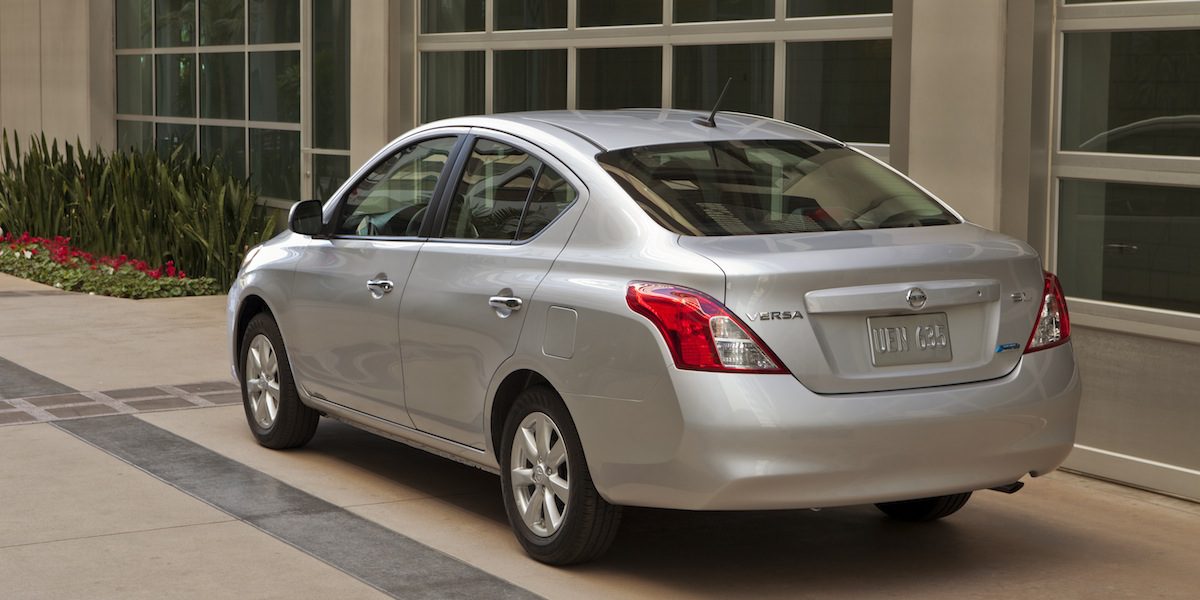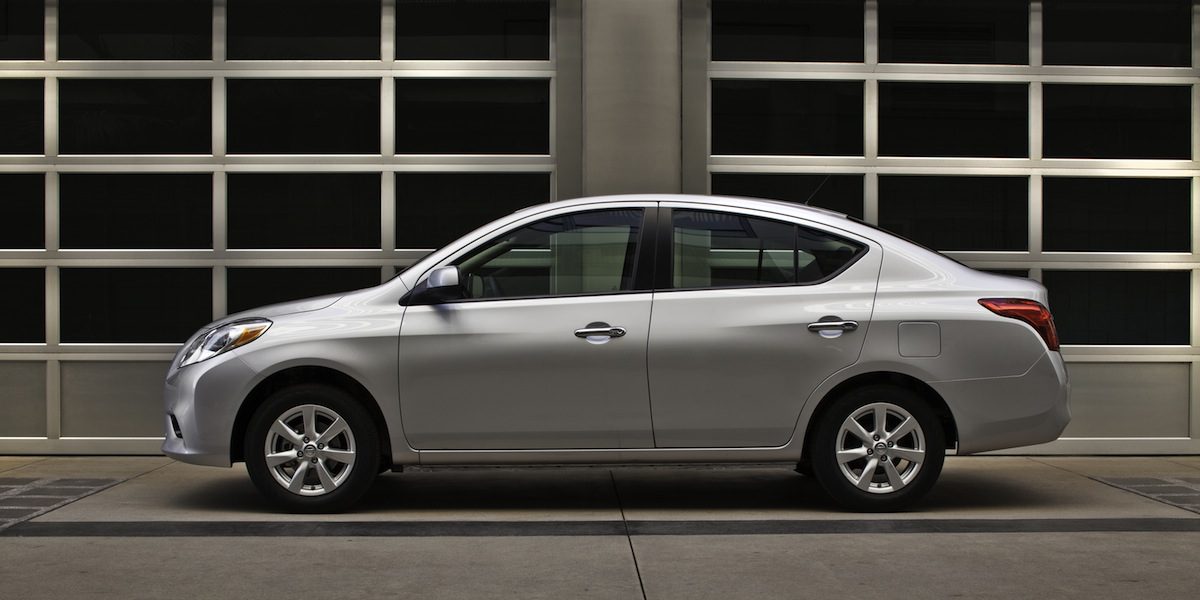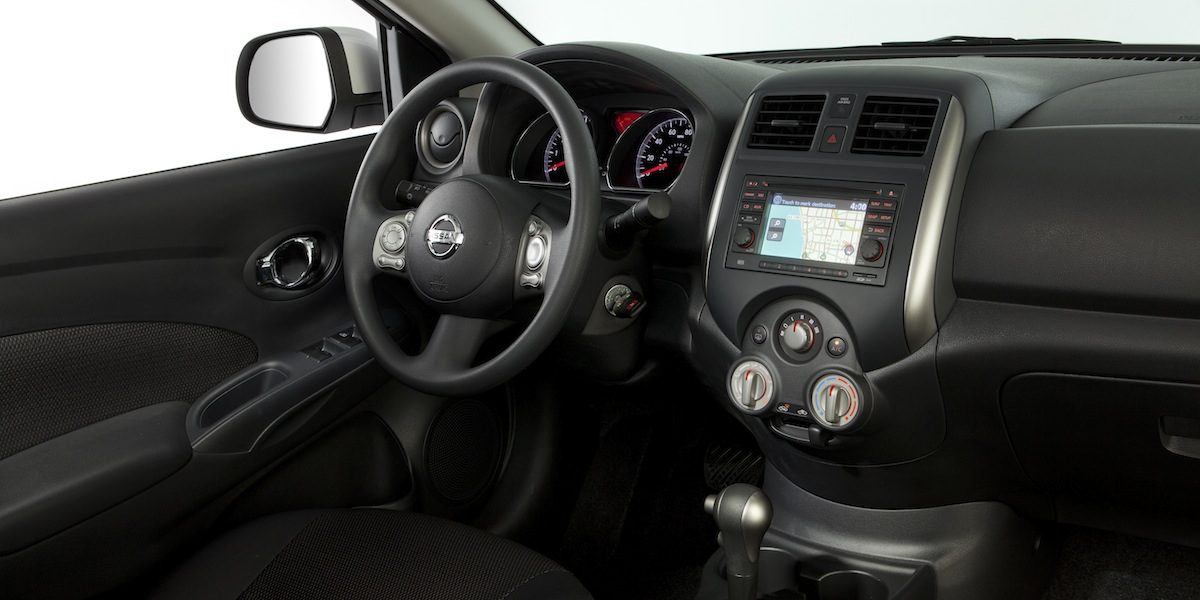| Compact car; Built in |
|
|
| Good condition price range: $5,800 – $14,700* |

2012 Nissan Versa

2012 Nissan Versa

2012 Nissan Versa

2012 Nissan Versa
| Pros: |
|
| Cons: |
|
Versa is priced like a subcompact, but its blend of room, comfort, and overall refinement are an easy match for any number of more-expensive compact cars. Modest acceleration and some obvious cost cutting are disappointing, but those negatives are balanced by the car’s fine road manners. Regardless, if you’re on a tight budget and considering buying a used car, either Versa is worth checking out.
Overview
Most notably, when new the redesigned 2012 Versa 4-door sedan was by far the least-expensive new car sold in the U.S. Note that the 4-door hatchback version of the Versa carried on little-changed from 2011, and its starting price–and equipment level–was much higher than the new sedan’s. Something else that was noteworthy about the sedan was that while most inexpensive entry-level cars are subcompacts, the Versa sedan was large enough and roomy enough to be considered a compact. As such, it competed not only against inexpensive subcompact cars, but also against compact family sedans such as the Chevrolet Cruze, Ford Focus, Honda Civic, Hyundai Elantra, Mazda 3, and Toyota Corolla. The Versa hatchback was also a compact, and competed against those cars plus another hatchback, the Volkswagen Golf. Both the Versa sedan and hatchback were built in Mexico.
As we mentioned above, almost nothing was new on the 2012 Versa hatchback. On the sedan though, virtually everything was. The sedan’s styling was much more fluid than its boxy predecessor, and though it was about the same size, it was projected to get better fuel economy.
Versa sedans came in three trim levels: 1.6 S, 1.6 SV, and 1.6 SL. The S was sparsely equipped, but did come with air conditioning, AM/FM/CD with stereo input jack, and a height-adjustable driver seat. Cruise control was optional. SV added cruise control and power windows/mirrors/locks with remote; options included a wireless cell-phone link and iPod interface. SL added a split folding rear seat, iPod interface, wireless cell-phone link, and alloy wheels. Options included a navigation system, satellite radio, and USB port.
Versa hatchbacks were offered in 1.8 S and 1.8 SL trim levels. The S hatchback started out better equipped than the S sedan, so it added a split-folding rear seat and power windows/mirrors/locks, but deleted the height-adjustable driver seat. Options included cruise control, remote entry, iPod interface, wireless cell-phone link, navigation system, satellite radio, USB port, and alloy wheels. The SL hatchback was very well equipped with standard cruise control, height-adjustable driver seat, remote entry, keyless access and starting, iPod interface, wireless cell-phone link, and alloy wheels. Options included satellite radio, navigation system, and a USB port.
All sedans were equipped with a 109-horsepower 1.6-liter 4-cylinder engine. Only the base S was offered with a 5-speed manual transmission; optional on the S and standard on other sedans was a continuously variable transmission (CVT) that behaved much like an automatic.
All hatchbacks had a 122-horsepower 1.8-liter 4-cylinder. The base S offered either a 6-speed manual transmission or a 4-speed automatic. The SL only was sold with a CVT, which behaved much like an automatic.
All Versas were front-wheel drive.
EPA ratings for the 2012 sedan were 27 city/36 highway with the manual transmission, 30/38 with the CVT. These figures were up by 1-2 mpg with manual, 5 mpg with the CVT. In Consumer Guide testing, a Versa sedan with the CVT averaged 37.5 mpg in mostly highway driving–quite frugal for the class.
Hatchbacks with the 6-speed manual transmission were rated at 26/31; with the 4-speed automatic, 24/32; with the CVT, 28/34. It’s interesting to note that the same car with the same engine gets 2-4 mpg more with the CVT than with the conventional 4-speed automatic. In Consumer Guide testing, Versa hatchbacks have averaged between 24.5 mpg and 27.4 mpg in a mix of city/highway driving.
Yearly Updates
| 2012 Versa After their redesign for 2012, Versa sedans saw only minor changes for 2013–mainly the addition of a traditional automatic transmission and a shuffling of trim levels and package content. Versa sedans were now sold in four trim levels: 1.6 S, 1.6 S Plus, 1.6 SV, and 1.6 SL. As mentioned above, the previous-generation Versa hatchback design continued through calendar 2012, but Nissan did not offer it as a 2013 model. |
| 2013 Versa Nissan retuned the Versa sedan’s suspension and steering for 2014. There were also some minor features added based on trim level. Nissan also introduced a new Versa Note hatchback for 2014, but it is reviewed in its own report. |
